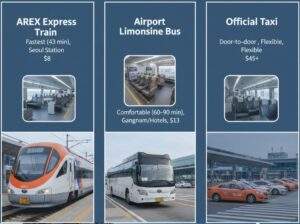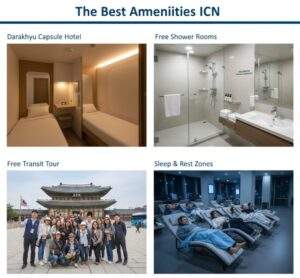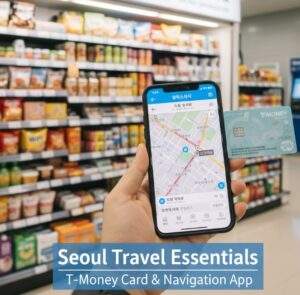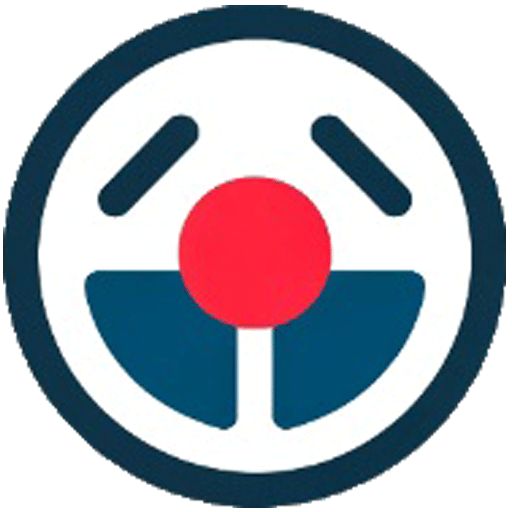Your Personal Incheon International Airport Guide: Unlock Seoul & Beyond
Landing in Seoul soon? Imagine stepping off a 14-hour flight. You’re exhausted, your skin is dry from the cabin air, and you’re suddenly standing in one of the largest buildings on the planet. The signs are in Korean, the crowds are moving fast, and you just want to find your hotel.
Incheon International Airport (ICN) is consistently ranked as one of the best airports in the world, but it is massive. Ignoring the logistics here is a rookie mistake. Taking the wrong “black taxi” can cost you triple the price. Missing the train cutoff could leave you stranded. And walking past the free shower facilities during a layover? That’s just a missed opportunity.
Relax. This isn’t just a list of facts; it’s your tactical roadmap. Whether you need to rush to Gangnam for a meeting or you have 7 hours to kill before your connection to Sydney, this guide covers the exact steps to navigate South Korea’s world-class hub like a local.
1. The Pre-Flight Check: Which Terminal Are You?
Before you even fasten your seatbelt, you need to know where you are landing. Incheon has two main terminals that are physically capable of functioning as separate airports. They are about 20 minutes apart by shuttle bus, so you do not want to mix them up.
Terminal 1 (The Main Hub)
This is the original terminal and handles the highest volume of traffic. If you are flying Star Alliance or Oneworld, you are likely here.
-
Key Airlines: Asiana Airlines, United Airlines, Lufthansa, Emirates, Singapore Airlines, Qatar Airways.
-
Low-Cost Carriers: Jeju Air, T’way, Air Seoul (often located in the “Concourse,” a satellite building connected by an underground train).
Terminal 2 (The SkyTeam Hub)
Newer, sleeker, and less crowded. This is the home base for SkyTeam.
-
Key Airlines: Korean Air, Delta, Air France, KLM.
-
Note: If you are flying on a codeshare ticket (e.g., a Delta flight operated by Korean Air), always check your operating carrier. You go to the terminal of the airline whose plane you are sitting on.
Pro Tip: Flying Jin Air? Despite being a budget carrier, they recently moved to Terminal 2. Double-check your ticket!
2. Arrival Logistics: Immigration & Connectivity
Once you land, follow the “Arrivals” signs. If you land in the Terminal 1 Concourse, you will take a short shuttle train to the main terminal. Warning: This is a one-way trip. Do not get on this train if you are a transfer passenger trying to reach a gate in the Concourse.
Breeze Through Immigration
South Korea’s immigration is highly digitized. Most visitors will scan their passport and fingerprints electronically.
-
Q-Code: While paper forms are available on the plane, filling out the Q-Code (Quarantine Information) online before you fly can sometimes speed up the health check line, though requirements change based on global health trends.
-
K-ETA: Citizens of many countries (like the US) currently enjoy a temporary exemption from the K-ETA (Electronic Travel Authorization) through 2025, but always verify the latest entry requirements on the official government site before flying.
Get Connected Immediately (SIM vs. Wi-Fi)
Do not leave the Arrivals Hall (Airside) without internet. You will need Naver Maps or KakaoMap to survive in Seoul (Google Maps does not provide walking directions in Korea).
| Option | Best For… | Price (Approx.) | Where to Buy |
| eSIM | Modern Phones (iPhone 11+) | ~$15 – $20 USD | Buy online (Airalo/Klook) before flying. Activate on landing. |
| Physical SIM | Older Phones / Voice Calls | ~$25 USD | Counters at Arrivals Hall (CU, KT, SKT Roaming). |
| Pocket Wi-Fi | Groups / Laptops | ~$3 – $5 USD/day | Rental counters at Arrivals. Must return before departure. |
Monetization Tip: Pre-booking your SIM card or Pocket Wi-Fi via Klook or Trazy is usually 10-20% cheaper than the walk-up price at the counter. Plus, you just show a QR code and skip the payment hassle.
3. Getting to Seoul: The Transport Showdown

This is where most travelers lose money. You have three main options to get to downtown Seoul (approx. 30 miles/48 km away).
Option A: The AREX (Airport Railroad Express)
The train is the most reliable way to beat Seoul’s notorious traffic. There are two types of trains running on the same track.
1. The Express Train (Orange)
-
Route: Non-stop from Incheon T1/T2 to Seoul Station.
-
Time: ~43 minutes (T1) to 51 minutes (T2).
-
Cost: ~11,000 KRW (approx. $8 USD).
-
Vibe: Assigned comfortable seating, free Wi-Fi, luggage racks, quiet.
-
Best For: Solo travelers, couples, and anyone staying near Seoul Station or Myeongdong.
2. The All-Stop Train (Blue)
-
Route: Stops at 13 stations (including Hongdae and Gimpo Airport) on the way to Seoul Station.
-
Time: ~59 to 66 minutes.
-
Cost: ~4,750 KRW (approx. $3.50 USD).
-
Vibe: It’s a subway. Plastic bench seats, standing room only during rush hour, no luggage racks.
-
Best For: Budget backpackers or anyone staying in Hongdae (Hongik University Station).
Option B: The Airport Limousine Bus
Don’t let the name fool you; it’s a premium coach bus, not a stretch limo.
-
Cost: ~18,000 KRW (approx. $13 USD).
-
Why take it? If you are staying in Gangnam, Jamsil, or have heavy luggage, this is superior to the train. The bus drops you right in front of major hotels. Dragging two suitcases up the stairs of a Seoul subway station is a nightmare you want to avoid.
-
Tickets: Buy at the ticket kiosks outside the arrival gates (curbside).
Option C: Taxis
-
Standard Taxi (Orange/Silver/White): ~60,000 – 80,000 KRW ($45 – $60 USD) to downtown.
-
International Taxi: Flat rates, English-speaking drivers. Look for the “International Taxi” desk.
-
Uber/KakaoT: You can use the Uber app in Korea (it calls local taxis), or download KakaoT for better local integration.
-
The “Black Taxi” Warning: You will see older men in the arrivals hall whispering “Taxi? Taxi?” Ignore them. These are illegal touts who will overcharge you. Only use the official taxi line outside.
4. The Layover Survival Guide (4+ Hours)

Stuck at ICN for a connection? You are in luck. Incheon is designed for comfort.
The “Darakhyu” Capsule Hotel
Located in the public area (landside) of both T1 and T2, these aren’t sci-fi pods but small, clean rooms with beds and showers.
-
Day Use (3 hours): Starting around 30,000 KRW (~$22 USD).
-
Overnight: ~65,000 – 80,000 KRW (~$50-$60 USD).
-
Booking: Essential to book weeks in advance. They sell out fast.
Free Shower Rooms
If you are a transit passenger (meaning you have a boarding pass for a connecting flight), showers are free.
-
Locations: Terminal 1 (near Gate 25 & 29) and Terminal 2 (near Gate 231 & 268).
-
Amenities: Towels and shampoo are usually provided. (Note: If you are not a transit passenger, there may be a small fee approx. 3,000 KRW).
Free Transit Tours
Got a layover between 5 and 24 hours? The airport offers government-subsidized tours.
-
Options: 1-hour temple visits, 4-hour Seoul city tours, or 5-hour trips to the DMZ (sometimes requires a fee).
-
Registration: “Transit Tour” desks are visible in the main transfer areas. It is first-come, first-served, so go there immediately upon landing.
Sleep & Rest Zones
Don’t want to pay for a hotel? Look for the “Nap Zones” on the 4th floor of the transfer areas. They feature dark lighting and long, padded recliners that are surprisingly comfortable—and completely free.
5. Money & Convenience
Currency Exchange
-
The Rule: Exchange only what you need for the first day (taxi/bus money) at the airport. Airport rates are generally poor.
-
Better Option: Withdraw cash from a Global ATM in the arrivals hall (look for the “Global” logo on the machine).
-
Best Option: Use a WOWPASS or NAMANE card. These are prepaid debit cards for tourists that you can load with foreign currency.
The T-Money Card (Essential)

Go to any convenience store (CU, GS25, 7-Eleven) in the airport arrivals hall and ask for a T-Money card.
-
Cost: 4,000 KRW for the card (empty).
-
Load it: Put 20,000 KRW cash on it.
-
Use it: You tap this card to ride subways, buses, and taxis. You can also use it to buy drinks at convenience stores. It is the lifeblood of Seoul travel.
6. Departure Pro-Tip: The “City Airport” Check-In
This is the best-kept secret of Korean travel. If you are flying Korean Air, Asiana, or select other carriers, you can check your bags and clear immigration in downtown Seoul (at Seoul Station or COEX in Gangnam) before you even go to the airport.
-
Check your bags at the city terminal in the morning.
-
Get your boarding pass and go through “City Immigration.”
-
Spend the rest of the day exploring bag-free.
-
Take the AREX to the airport.
-
At Incheon, use the “Designated Entrance” (a special VIP side door) to skip the massive security lines.
Frequently Asked Questions (FAQ)
Q: Can I sleep at Incheon Airport overnight?
A: Yes. If you are airside (transit), use the Nap Zones or Transit Hotel. If you are landside (public area), you can use the Darakhyu Capsule Hotel or rest on the benches in the arrivals hall, though it’s less comfortable. The “Spa on Air” (sauna) in Terminal 1 is a popular 24-hour option for sleeping, but it fills up quickly.
Q: Do I need a visa for a layover in Korea?
A: If you stay inside the airport (airside), you generally do not need a visa. If you want to leave the airport to enter Seoul, you must clear immigration. Check if your country requires a K-ETA or Visa. (US/Canada/EU citizens are often visa-exempt for short stays).
Q: Is 1 hour enough for a transfer at Incheon?
A: It is tight. If your flights are on the same ticket (checked through), 1 hour is doable because the airport is efficient. If you have to self-transfer (collect bags and re-check), you need at least 3-4 hours.
Q: What if I arrive after midnight?
A: The AREX trains stop running around midnight. Your options are the Late Night Bus (N6000 series) which runs to Seoul Station and Gangnam, or a taxi. Official taxis run 24/7.
Conclusion
Navigating Incheon Airport doesn’t have to be scary. It is one of the most efficient, clean, and traveler-friendly places on earth if you know how to use it.
-
Take the AREX Express for speed.
-
Take the Limousine Bus for Gangnam comfort.
-
Buy a T-Money card immediately.
-
Use the Nap Zones to recharge.
Start your Korean adventure the right way—stress-free and fully charged.
Recommended Articles: The Ultimate Seonjeongneung Tombs Walking Guide: A Peaceful Escape in Gangnam
Recommended Articles: Seongsu-dong vs. Hongdae: Which Seoul Neighborhood Is Right For You? (2025 Guide)
Hi, I’m [jeybee]. As a long-time resident of Seoul, I’m passionate about uncovering the authentic, everyday magic of Korea. This blog is my way of sharing my favorite spots, tips, and cultural insights with you, beyond the usual tourist traps.

